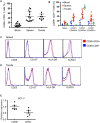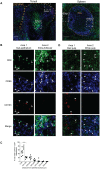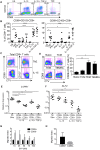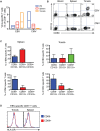Compartmentalization of Total and Virus-Specific Tissue-Resident Memory CD8+ T Cells in Human Lymphoid Organs
- PMID: 27540722
- PMCID: PMC4991796
- DOI: 10.1371/journal.ppat.1005799
Compartmentalization of Total and Virus-Specific Tissue-Resident Memory CD8+ T Cells in Human Lymphoid Organs
Abstract
Disruption of T cell memory during severe immune suppression results in reactivation of chronic viral infections, such as Epstein Barr virus (EBV) and Cytomegalovirus (CMV). How different subsets of memory T cells contribute to the protective immunity against these viruses remains poorly defined. In this study we examined the compartmentalization of virus-specific, tissue resident memory CD8+ T cells in human lymphoid organs. This revealed two distinct populations of memory CD8+ T cells, that were CD69+CD103+ and CD69+CD103-, and were retained within the spleen and tonsils in the absence of recent T cell stimulation. These two types of memory cells were distinct not only in their phenotype and transcriptional profile, but also in their anatomical localization within tonsils and spleen. The EBV-specific, but not CMV-specific, CD8+ memory T cells preferentially accumulated in the tonsils and acquired a phenotype that ensured their retention at the epithelial sites where EBV replicates. In vitro studies revealed that the cytokine IL-15 can potentiate the retention of circulating effector memory CD8+ T cells by down-regulating the expression of sphingosine-1-phosphate receptor, required for T cell exit from tissues, and its transcriptional activator, Kruppel-like factor 2 (KLF2). Within the tonsils the expression of IL-15 was detected in regions where CD8+ T cells localized, further supporting a role for this cytokine in T cell retention. Together this study provides evidence for the compartmentalization of distinct types of resident memory T cells that could contribute to the long-term protection against persisting viral infections.
Conflict of interest statement
The authors have declared that no competing interests exist.
Figures






Similar articles
-
Epstein-Barr virus infection induces tissue-resident memory T cells in mucosal lymphoid tissues.JCI Insight. 2024 Oct 22;9(20):e173489. doi: 10.1172/jci.insight.173489. JCI Insight. 2024. PMID: 39264727 Free PMC article.
-
Cytomegalovirus-seropositive children show inhibition of in vitro EBV infection that is associated with CD8+CD57+ T cell enrichment and IFN-γ.J Immunol. 2013 Dec 1;191(11):5669-76. doi: 10.4049/jimmunol.1301343. Epub 2013 Oct 18. J Immunol. 2013. PMID: 24140645 Free PMC article.
-
Evaluation of suitable target antigens and immunoassays for high-accuracy immune monitoring of cytomegalovirus and Epstein-Barr virus-specific T cells as targets of interest in immunotherapeutic approaches.J Immunol Methods. 2014 Jun;408:101-13. doi: 10.1016/j.jim.2014.05.011. Epub 2014 May 28. J Immunol Methods. 2014. PMID: 24877879
-
The Emerging Role of CD8+ Tissue Resident Memory T (TRM) Cells in Antitumor Immunity: A Unique Functional Contribution of the CD103 Integrin.Front Immunol. 2018 Aug 15;9:1904. doi: 10.3389/fimmu.2018.01904. eCollection 2018. Front Immunol. 2018. PMID: 30158938 Free PMC article. Review.
-
Cellular immune responses in transplantation-associated chronic viral infections.Transpl Infect Dis. 2002 Mar;4(1):31-40. doi: 10.1034/j.1399-3062.2002.00006.x. Transpl Infect Dis. 2002. PMID: 12123424 Review.
Cited by
-
Infection and immune control of human oncogenic γ-herpesviruses in humanized mice.Philos Trans R Soc Lond B Biol Sci. 2019 May 27;374(1773):20180296. doi: 10.1098/rstb.2018.0296. Philos Trans R Soc Lond B Biol Sci. 2019. PMID: 30955487 Free PMC article. Review.
-
Identification and characterization of HIV-specific resident memory CD8+ T cells in human lymphoid tissue.Sci Immunol. 2018 Jun 1;3(24):eaar4526. doi: 10.1126/sciimmunol.aar4526. Sci Immunol. 2018. PMID: 29858286 Free PMC article.
-
Identification of resident memory CD8+ T cells with functional specificity for SARS-CoV-2 in unexposed oropharyngeal lymphoid tissue.Sci Immunol. 2021 Oct 22;6(64):eabk0894. doi: 10.1126/sciimmunol.abk0894. Epub 2021 Oct 22. Sci Immunol. 2021. PMID: 34519539 Free PMC article.
-
SARS-CoV-2 spike-specific nasal-resident CD49a+CD8+ memory T cells exert immediate effector functions with enhanced IFN-γ production.Nat Commun. 2024 Sep 27;15(1):8355. doi: 10.1038/s41467-024-52689-5. Nat Commun. 2024. PMID: 39333516 Free PMC article.
-
Resident Memory T Cells and Their Effect on Cancer.Vaccines (Basel). 2020 Oct 1;8(4):562. doi: 10.3390/vaccines8040562. Vaccines (Basel). 2020. PMID: 33019493 Free PMC article. Review.
References
Publication types
MeSH terms
Substances
Grants and funding
LinkOut - more resources
Full Text Sources
Other Literature Sources
Medical
Research Materials

